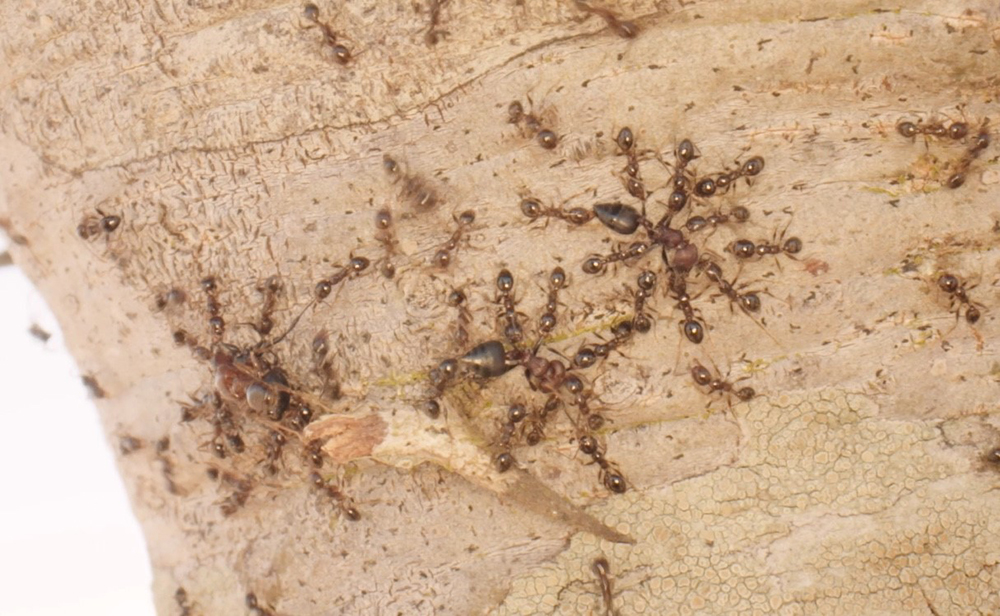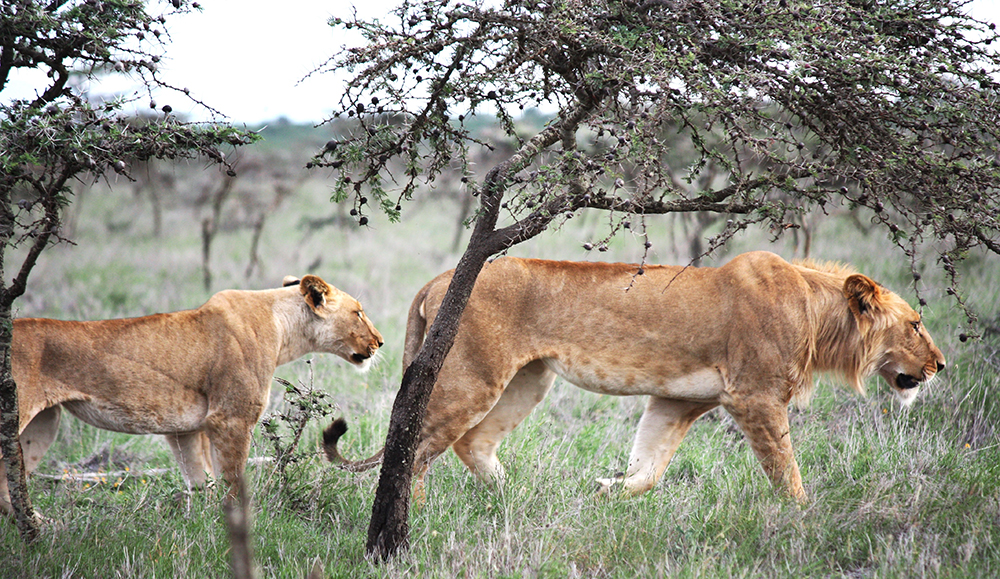
Lions, elephants, zebras, buffalo, ants, and trees are all locked in an intricate ecological web in one Kenyan nature preserve. But that web is unraveling as a small invader disrupts the natural balance of things, according to a study published January 24 in the journal Science.
The spread of an invasive insect across the savannah habitat of Ol Pejeta Conservancy has triggered a domino effect. The fallout leaves lions less able to hunt zebras–their primary prey– and has prompted the big cats to pursue larger and potentially more dangerous buffalo, says Todd Palmer, one of the study authors and a biology professor at the University of Florida. Other major ecosystem shifts, like loss of bird habitat and declining soil health, are likely also occurring.
The new research builds on past work to demonstrate just how delicate and complex the savannah ecosystem is. More broadly, it shows how important mutualisms (mutually beneficial relationships between species) can be in habitats around the world. When the connections between organisms are disrupted, it can have serious conservation consequences.
A changing landscape
It all starts with a well-documented symbiosis between whistling-thorn acacia trees, which are the most common woody plant in Ol Pejeta, and native acacia ants. The trees provide the ants with habitat and nectar to eat. In return, the ants protect the trees from would-be megaherbivores, like elephants, with their nasty bites. This relationship is considered a foundational one: a mutualism that shapes the landscape by allowing acacia trees to thrive amid many large plant-hungry animals– but it’s in peril.
Big-headed ants, an aggressive and predatory invasive species, are destabilizing that foundation by displacing the native acacia ants. When big-headed ants come to an acacia ant nest, they wreak havoc–killing and eliminating their native competition. And unlike their native counterparts, big-headed ants do nothing to defend acacias. As a result, elephants and other herbivores more easily graze on the trees, leaving few trunks left in areas colonized by the big-headed ants. A savannah invaded by big-headed ants is a much more open habitat, largely devoid of brush and woodland.

Palmer and his co-researchers have observed and studied this transition over the past two decades as the invasive ants have spread. It’s led the scientists to wonder how other animals are being impacted by the landscape change. In this most recent study, they focus on the predator/prey dynamic between lions and zebras.
Lions are ambush predators and previous research suggests that they use tree cover to help them hide and surprise their prey. Zebras in Ol Pejeta are skittish and prefer to spend time in open, high-visibility areas where possible. As the ant invasion leaves the Kenyan savannah more open, lions seem to be losing out on opportunities to hunt and kill zebras, according to the study findings. Additionally, the big cats seem to be supplementing their diet with buffalo.
“This little invasive ant has really rearranged the species interactions,” in Ol Pejeta, Palmer says. “It has dramatically influenced the most iconic African predator, the lion, and its primary prey species.”
Experiments and observation
To come to that conclusion, the research team collected years of observations and conducted long-term experiments in the nature preserve. First, to confirm that big-headed ant invasions lead to more grazing by elephants and fewer acacia trees, they monitored three sets of four big experimental plots. Half the plots were in areas where big-headed ants had invaded and half were in parts of the preserve where the ants hadn’t yet arrived. In half the plots, they used electric fencing to keep out megaherbivores like elephants and giraffes. After three years, they assessed their plots and found, among the unfenced plots, visibility was 2.67 times higher where big-headed ants were present. There was no significant difference between visibility in the fenced plots, regardless of whether or not the invasive ants were present, signaling herbivory was the difference-maker.
Then, Palmer and his colleagues tracked six prides of lions with GPS collars. They used this data to keep tabs on zebra kills over a several month period. In total, the researchers documented 55 different instances where lions killed zebras within the preserve. Through a nested path analysis, which is a sort of statistical Occam’s razor, the scientists found that zebra kills were 2.87 times more common in areas free of big-headed ants than in invaded areas.

Over the study period, the researchers didn’t find any increase in zebra density. (Palmer explains that zebra populations are more restricted by food availability than by predation.) More surprisingly, the researchers also didn’t note a drop in the lion population. To the scientists, the stable lion numbers indicated the predators were relying on alternative prey. And, in fact, additional data collected by land managers and surveyors at Ol Pejeta supports this. From 2003 to 2020, zebras became a smaller proportion of observed lion kills, going from 67 percent to 42 percent. Buffalo, on the other hand, went from zero percent of recorded lion kills in 2003 to 42 percent of all kills in 2020.
All in all, the researchers have “meticulously pieced together the causes and consequences,” of an invasive insect in central Kenya, writes Kaitlyn Gaynor, an ecology professor at the University of British Columbia who was not involved in the study, in an accompanying commentary article. As Gaynor describes the new study, it’s thorough and revealing research into a complex system.
There are, however, some important limits to the findings, says Palmer. They were able to show associations and suggest likely explanations, but much of their research doesn’t conclusively prove any pattern, he notes. For instance, the data on the rise in buffalo kills is only correlational–the scientists can’t say for certain that it’s being caused by the invasive ants. And why buffalo have become the new prey of choice isn’t yet clear. Palmer hypothesizes that Buffalo are less vigilant than zebras, and so might be spending more time in less open areas of the savannah, but follow-up research is needed to further explore this theory and to assess if the buffalo population is changing amid the new pressure of lion predation. Yet still, the work has big implications for the ecosystem’s future.
An uncertain future
So far, the lion population has remained stable, but Palmer says that could change moving forward. Buffalo are larger and risky prey for lions to take on. It’s possible that more lions will incur hunting injuries by changing up their prey strategy. Hunting buffalo, which usually involves multiple lions working together, also likely takes more energy than hunting zebras. In the long term, that increased energy cost could add up to fewer cubs and smaller numbers. Plus, tree cover continues to decline and all of the lions’ wooded hiding places vanish, buffalo, too, will become harder to hunt.
Many other species are also at risk amid the ant invasion. Weaver birds that nest in the canopy of acacia trees lose habitat, says Palmer. Butterflies that associate with the acacia ants could disappear. Critically endangered black rhinos that rely on the acacia trees for food might be further imperiled. Carbon storage and soil health may decline as more trees die–whistling-thorn trees are legumes that add nitrogen to the soil. Without them, the savannah grasses could also suffer. At the moment, there’s no clear strategy for controlling the big-headed ants, he says.
In his years studying this system, Palmer says he’s seen parts of the landscape totally transform. “It’s kind of depressing,” he says–but it’s also an important lesson in biological complexity that could help reframe and refocus conservation efforts. “When most people think about conservation, they think about conserving species–saving the elephants or the lions or the zebras. We think a lot less often about the integrity of species interaction,” he explains. Perhaps it’s time to put more work into understanding and preserving the connections between organisms instead of just individual animals, he suggests. A lion isn’t just a lion, it’s part of a biological fabric. To keep that living cloth intact, every thread plays a role, even the humble ant.
The health of an ecosystem doesn’t just come down to who eats who, but also what a habitat looks like and where there are and aren’t shady hiding spots. As a result, the link between the smallest insect and the mightiest predator is both stronger and more tenuous than you might expect.
The post Invasive ants leave lions scrambling for prey on the savannah in an ecological chain reaction appeared first on Popular Science.
Articles may contain affiliate links which enable us to share in the revenue of any purchases made.
from Popular Science https://ift.tt/mqs7WAu




0 Comments